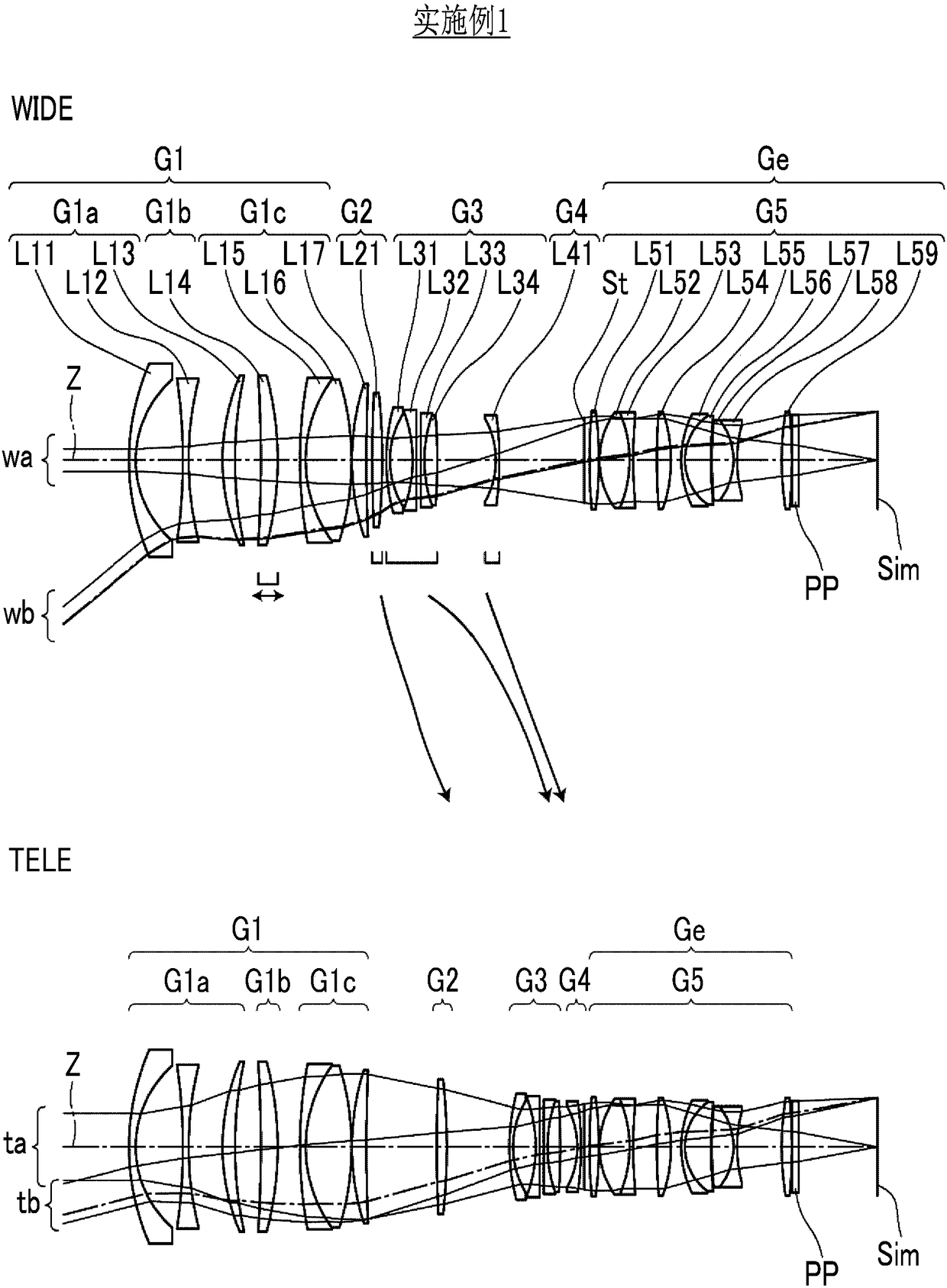Zoom lens and imaging apparatus
A zoom lens and lens group technology, which is applied in the field of zoom lenses and camera devices, can solve problems such as large lens diameters, achieve high optical performance, and achieve miniaturization and light weight effects
- Summary
- Abstract
- Description
- Claims
- Application Information
AI Technical Summary
Problems solved by technology
Method used
Image
Examples
Embodiment 1
[0128] The lens structure of the zoom lens of embodiment 1 is as figure 1 As shown, the illustration method is the same as above, so a part of repeated description is omitted here. The zoom lens of Example 1 includes, in order from the object side, a first lens group G1 having positive refractive power, a second lens group G2 having positive refractive power, a third lens group G3 having negative refractive power, and a fourth lens group G4 having negative refractive power And the fifth lens group G5 with positive refractive power. The intervals between these five lens groups in the optical axis direction from adjacent groups change when the magnification is changed. The moving lens groups are the second lens group G2, the third lens group G3, and the fourth lens group G4, and the final lens group Ge is the fifth lens group G5.
[0129] The first lens group G1 includes, in order from the object side, a first lens group front group G1a having a negative refractive power, a fi...
Embodiment 2
[0144] The lens structure and optical path of the zoom lens of embodiment 2 are shown in figure 2 middle. The group structure of the zoom lens of Example 2, the sign of the refractive power of each lens group, the lens groups that move when changing magnification, and the lens groups that move when focusing are the same as those of Example 1. The front group G1a of the first lens group includes three lenses of lenses L11 to L13 in order from the object side, the group G1b of the first lens group includes one lens of lens L14, and the rear group G1c of the first lens group includes lens L15 in order from the object side ~ L17 these 3 lenses. The second lens group G2 includes one lens of the lens L21. The third lens group G3 includes three lenses of lens L31 to lens L33 in this order from the object side. The fourth lens group G4 includes two lenses of lenses L41 to L42 in this order from the object side. The fifth lens group G5 includes an aperture stop St and nine lenses ...
Embodiment 3
[0153] The lens structure and optical path of the zoom lens of embodiment 3 are shown in image 3 middle. The zoom lens of Example 3 includes, in order from the object side, a first lens group G1 having positive refractive power, a second lens group G2 having positive refractive power, a third lens group G3 having negative refractive power, and a fourth lens group G4 having positive refractive power And the fifth lens group G5 with positive refractive power. The first lens group G1 includes a first lens group front group G1a, a first lens group middle group G1b, and a first lens group rear group G1c in order from the object side. The lens groups that move during zooming and the lens groups that move during focusing in the zoom lens of Example 3 are the same as those of Example 1.
[0154] The front group G1a of the first lens group includes three lenses of lenses L11 to L13 in order from the object side, the group G1b of the first lens group includes one lens of lens L14, an...
PUM
 Login to View More
Login to View More Abstract
Description
Claims
Application Information
 Login to View More
Login to View More - R&D
- Intellectual Property
- Life Sciences
- Materials
- Tech Scout
- Unparalleled Data Quality
- Higher Quality Content
- 60% Fewer Hallucinations
Browse by: Latest US Patents, China's latest patents, Technical Efficacy Thesaurus, Application Domain, Technology Topic, Popular Technical Reports.
© 2025 PatSnap. All rights reserved.Legal|Privacy policy|Modern Slavery Act Transparency Statement|Sitemap|About US| Contact US: help@patsnap.com



